A freshly reinvented garage unlocks some of the most valuable square metres in any home, turning an overlooked storage bay into a multitasking powerhouse that shelters cars, streamlines hobbies, and even earns back living space. By combining smart organisation systems, resilient finishes, and comfort-boosting upgrades—many of them weekend-DIY friendly—you can transform bare concrete and clutter into a room that feels purposeful and polished. The twenty makeover ideas below blend current design trends with practical building-science know-how, giving you a step-by-step roadmap from first sweep-out to final flourish.
1. Declutter and Zone Your Garage
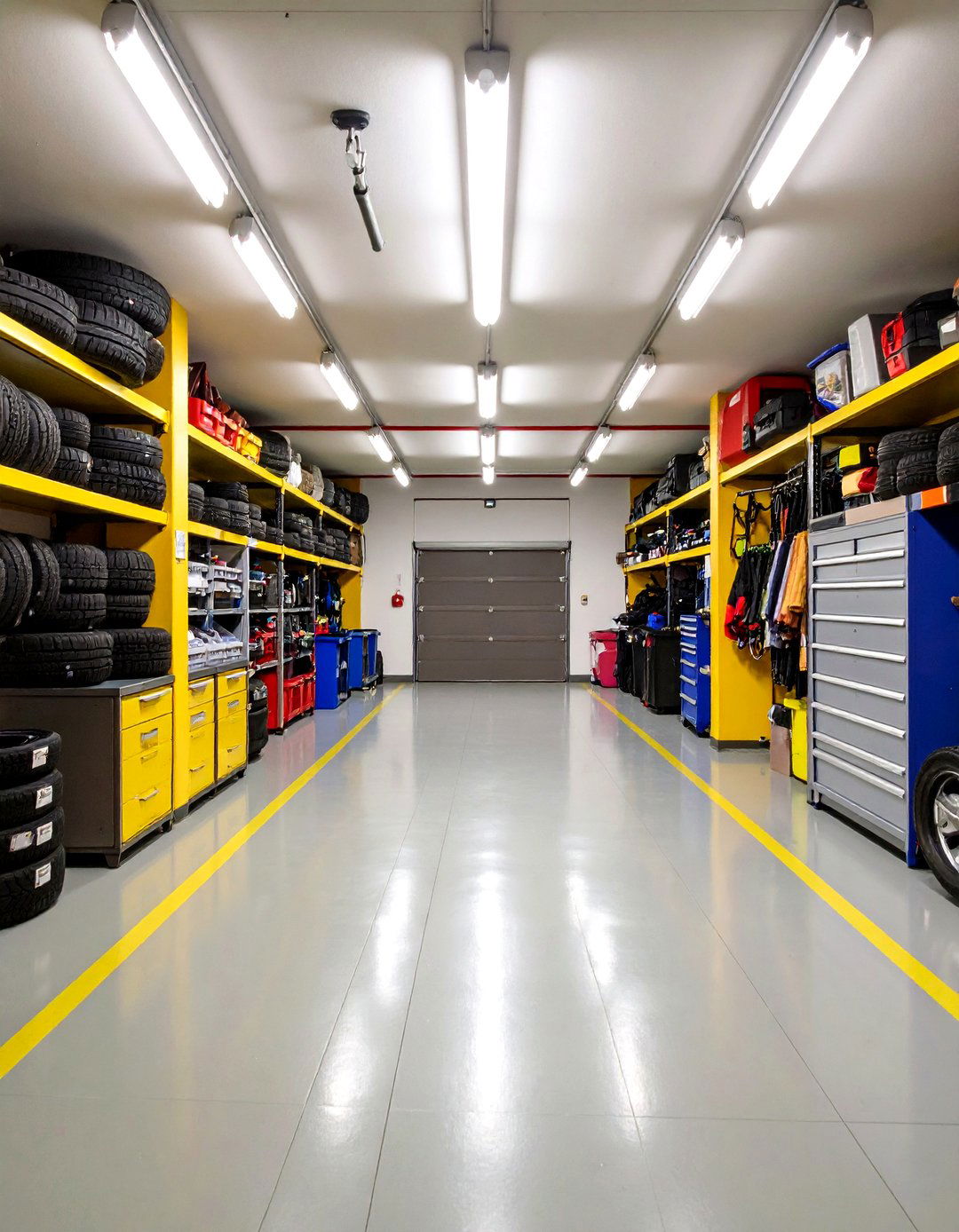
A chaotic garage quickly devours tools and tripping hazards alike, so the reboot always begins with a ruthless clear-out. Empty the entire space onto the driveway, group belongings into keep-donate-toss piles, and note anything contractors specifically warn against storing here—batteries, adhesives, and propane cylinders deteriorate or become dangerous under extreme temperatures. Once the floor is clean, sketch a simple layout that dedicates a vehicle bay, a project corner, and shelving for seasonal gear. Finish by taping three-foot “curb lanes” around car doors; those bright boundaries anchor future cabinets and keep traffic paths open, ensuring every later upgrade slots into an orderly framework.
2. Install Slatwall Panels to Maximise Garage Walls
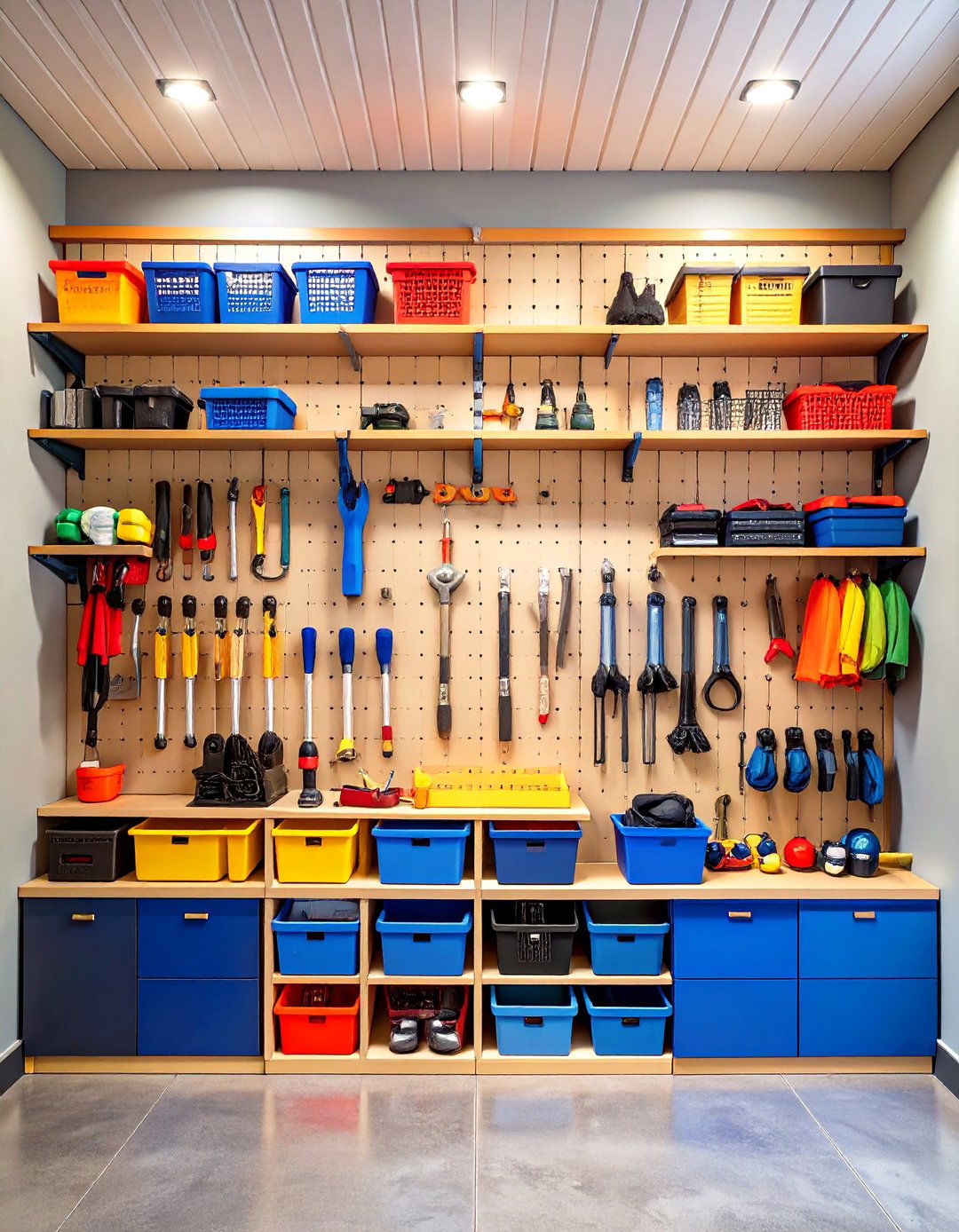
Unlike pegboard, modern PVC or MDF slatwall holds heavier loads, integrates shelves or wire baskets, and clips in place with almost no wasted vertical space, making it the undisputed champion for garage wall storage. Cut panels to fit between studs or run them floor-to-ceiling behind workbenches for a seamless look. Hooks lock firmly in the grooves, so even bulky ladders or bike frames stay put. Wrap high-use areas—such as the zone beside the entry door—with small accessory shelves for chargers and keys, then leave pull-out bins lower down for kids’ sports gear. Colour-matched trim turns the whole wall into a tidy, built-in feature.
3. Add Overhead Racks for Bulky, Light-Duty Storage
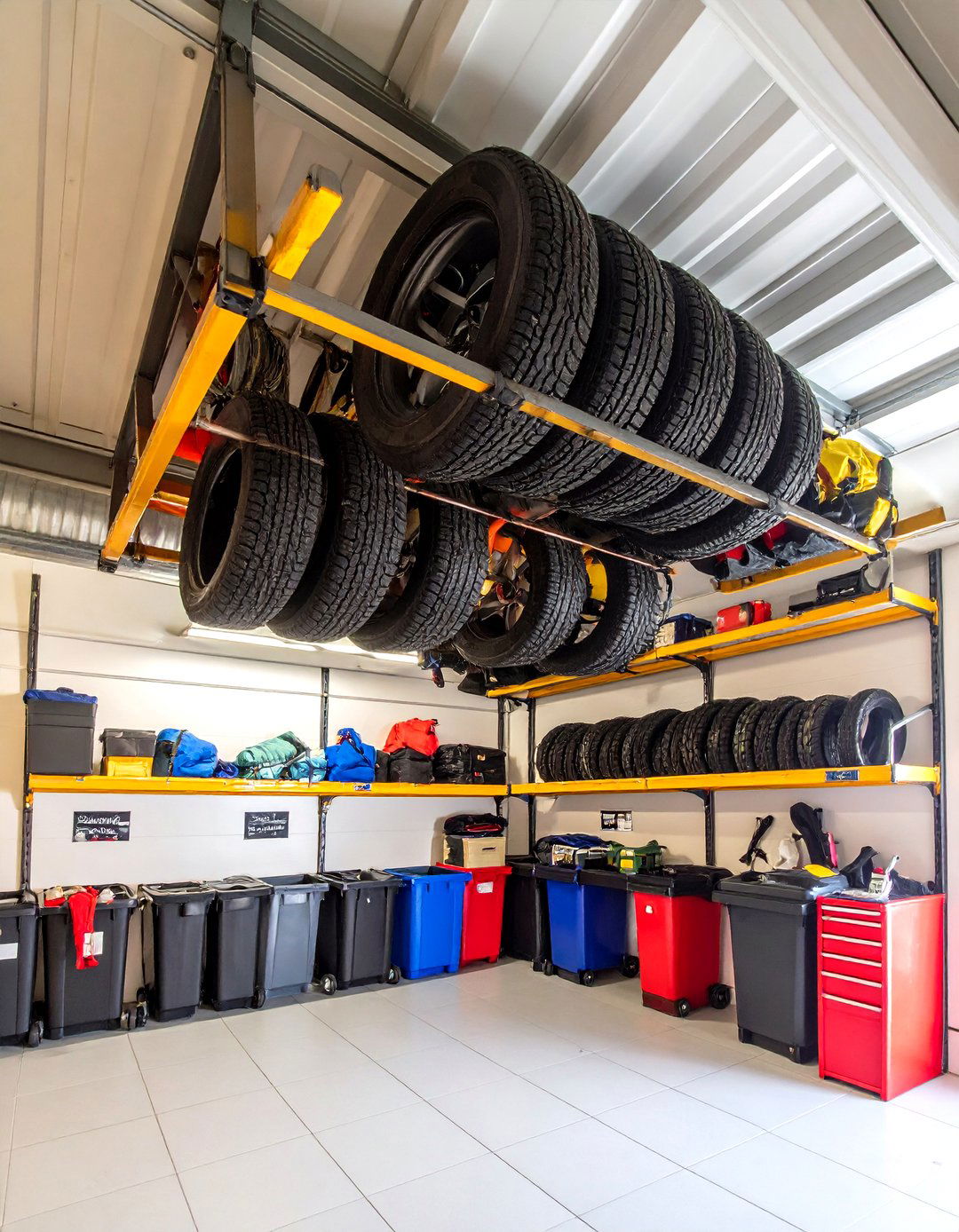
Take advantage of the ceiling void by bolting 14- to 20-inch-deep steel racks into joists. Quality units rated to 250–600 kg protect camping tents, snow tyres, and archive boxes while freeing precious floor space for everyday tasks. Keep clearance at least 46 cm above a raised garage door and use locking nylon bins to block dust. Mark each rack with bold labels that face the entrance so seasonal swap-outs happen in minutes instead of hours. Paired with slatwall, this “ground-up/ceiling-down” strategy leaves the mid-wall sweet spot open for cabinets and benches.
4. Upgrade to a Durable Epoxy or Polyaspartic Garage Floor
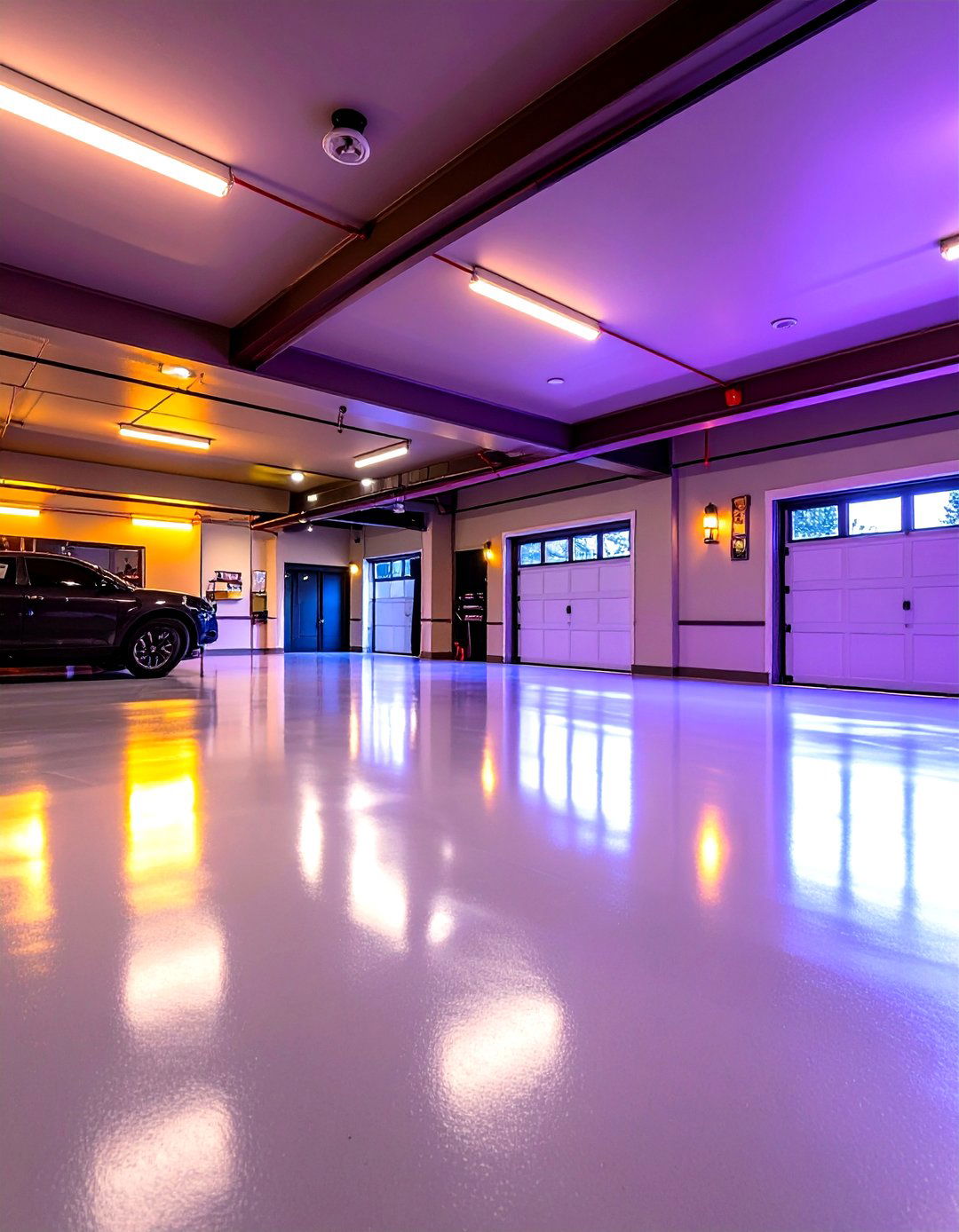
A drab concrete slab telegraphs stains and dust, but a two-part epoxy or next-gen polyaspartic coating delivers showroom shine plus chemical resistance. Epoxy remains a budget favourite, yet polyaspartic cures in as little as one hour and resists UV yellowing—a big benefit if your garage door stays open often. Degrease thoroughly, diamond-grind the surface, then roll on primer, colour chips, and a clear topcoat. The result brightens lighting by 30 percent, sweeps clean with a push broom, and seals hairline cracks that once telegraphed upward into tyres or tool chests.
5. Snap-Together Floor Tiles for Portable Flexibility
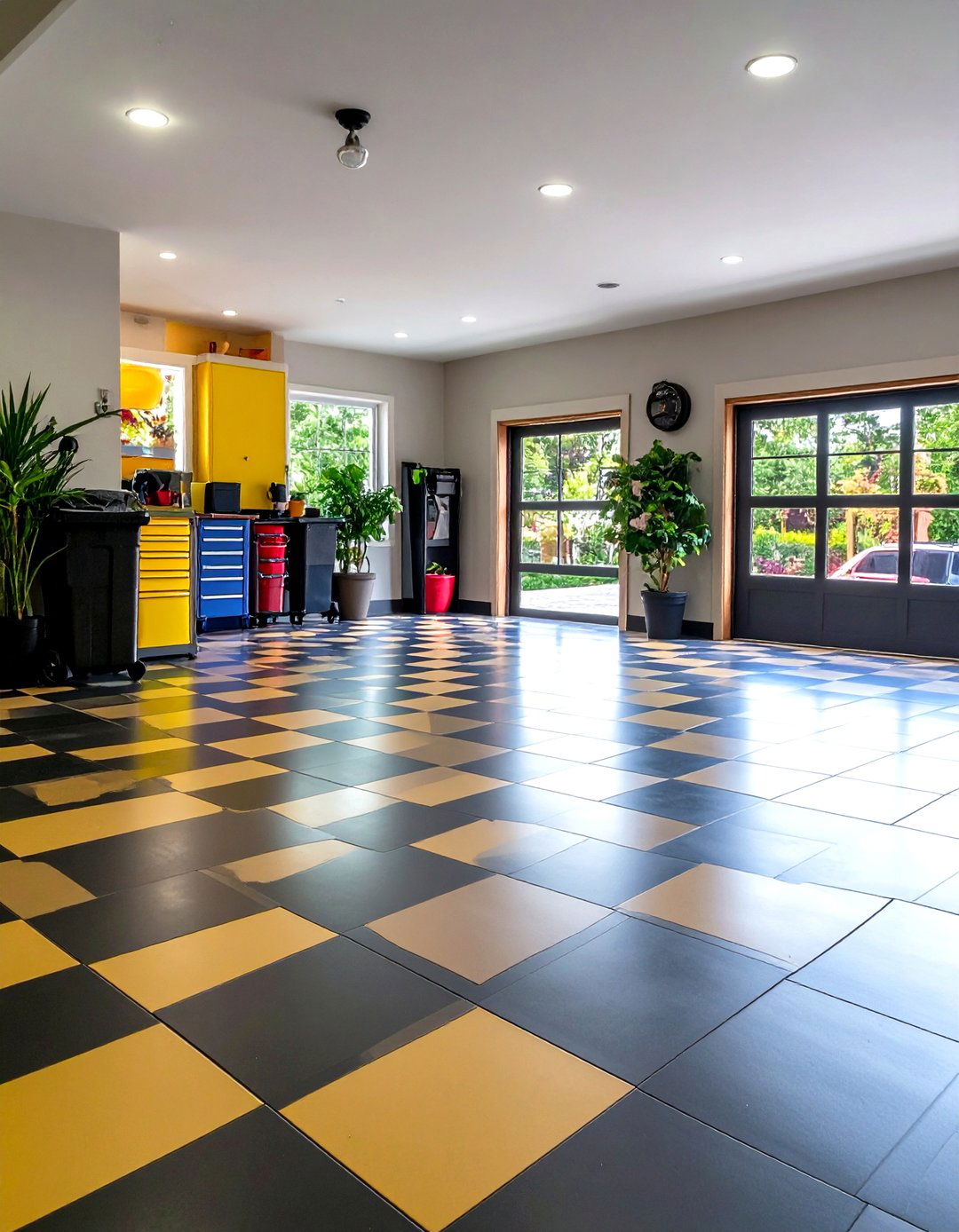
For renters or serial experimenters, interlocking polypropylene tiles are the flooring equivalent of LEGO®. They float over minor cracks, let water drain beneath, and can be lifted one square at a time to wash out spills—a benefit seasoned hobbyists praise online. Mix chequerboard patterns or outline a colourful parking pad; high-flow tile styles even vent moisture from below, reducing winter salt spalling. If you move, box them up and reinstall in the next garage without losing your investment.
6. Boost Visibility with High-CRI LED Lighting
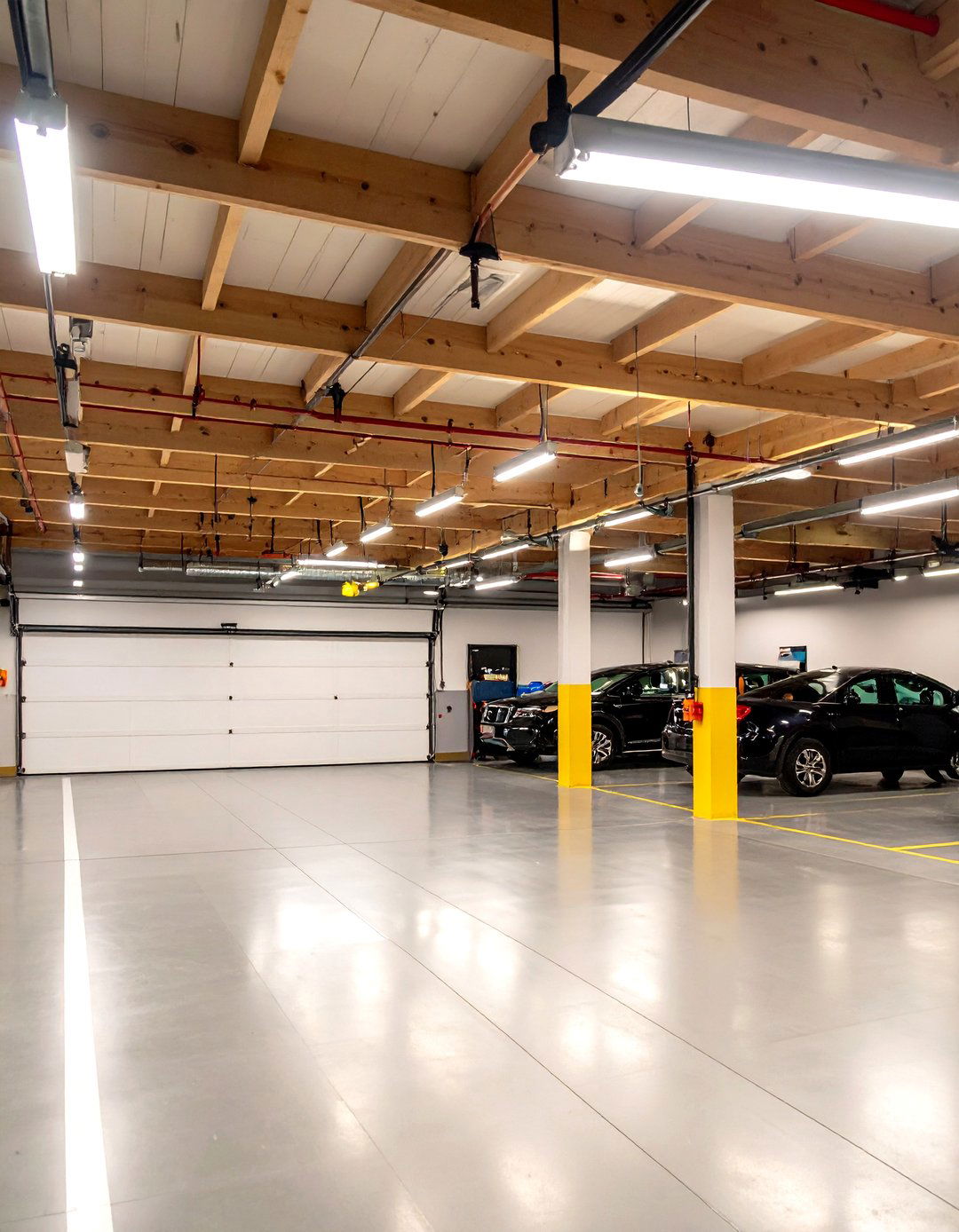
Dim 60-watt bulbs make precise work risky, so swap them for linkable LED shop lights delivering 50–75 lumens per square foot in task zones. A plug-in daisy chain along the ceiling beams casts even, shadow-free illumination, while motion sensors ensure hands-free entry when you carry groceries. Choose fixtures above 80 CRI (colour rendering index) so paint touch-ups and woodworking stains appear true, and install a separate, lower-level strip under shelving to prevent toe-stubs during late-night tool runs.
7. Integrate a Smart Garage-Door Controller

Adding a Wi-Fi hub to an existing opener lets you confirm the door’s status, share digital keys, and receive tamper alerts from anywhere—a game-changer for parcel deliveries or teenage drivers. Most retrofit kits install in under 30 minutes: mount the sensor on the panel’s top brace, run two low-voltage wires to the push button terminals, and scan a QR code. Schedule the door to auto-close at bedtime, then tie it into voice assistants so you can ask, “Did I shut the garage?” without leaving the couch.
8. Insulate and Weather-Seal the Envelope
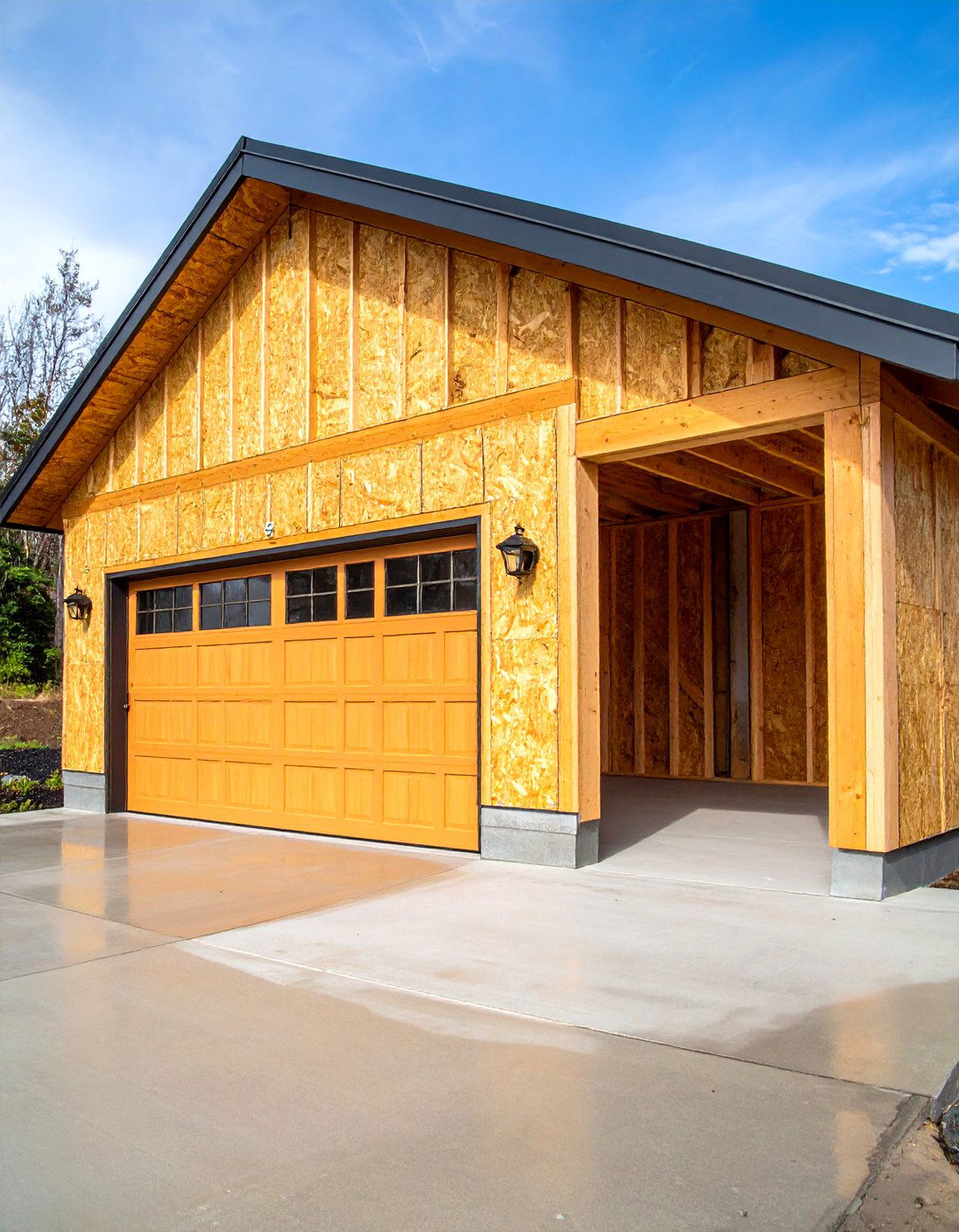
If you plan to heat or cool the garage, start by packing stud bays with R-13 to R-19 batts—higher R-values demand deeper cavities but pay dividends in comfort. Add self-adhesive bottom seals to the door, plug sill gaps with low-expansion foam, and hang a thermally broken, fire-rated door between garage and house. The climate buffer keeps stored paints from freezing, muffles street noise, and prepares the space for future temperature-sensitive uses like a studio or home gym.
9. Add an Efficient Electric or Infrared Garage Heater
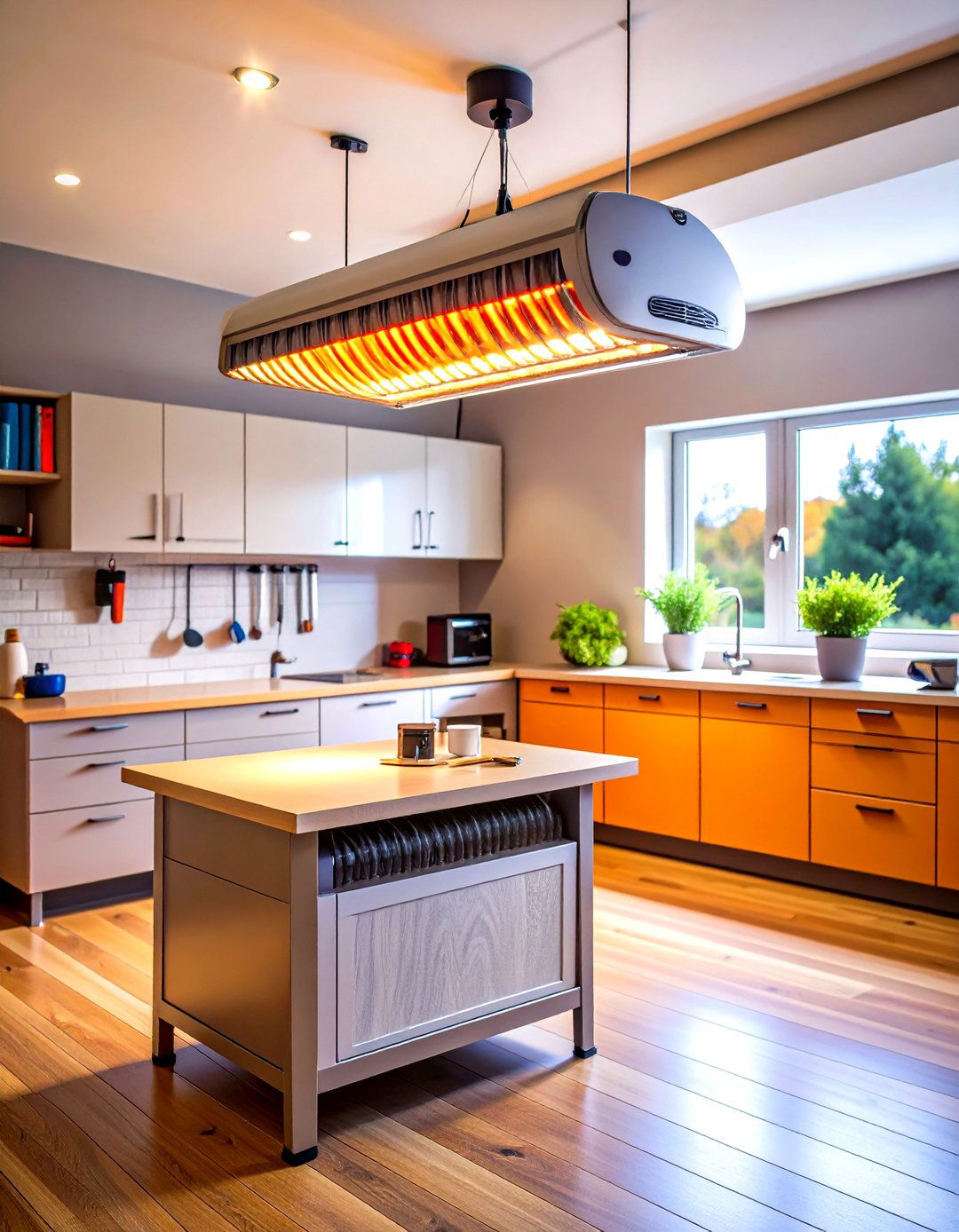
Quick-connect 240 V panel heaters or ceiling-mounted infrared units bring the room up to a workable 18 °C in minutes, and newer models boast digital thermostats plus mobile apps for off-site control. Infrared elements warm objects rather than air, making them ideal for draughty workshops; position them above the workbench so tools and fingers stay toasty. Pair the heater with a smart plug that shuts power if you accidentally leave it running, trimming utility bills without sacrificing comfort.
10. Transform a Garage Corner into a Compact Home Gym
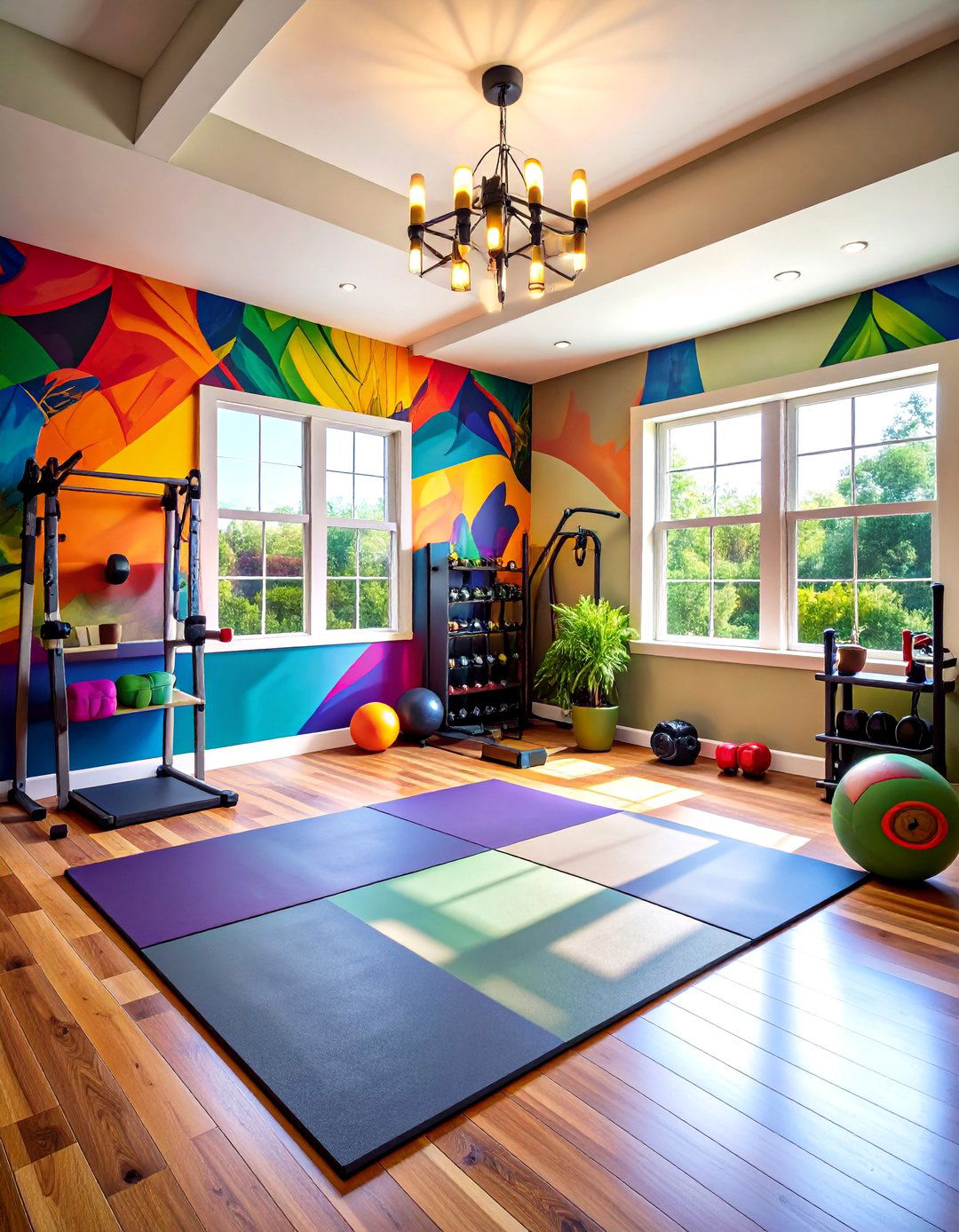
Rising remote-fitness culture means driveways no longer monopolise this square footage. Rubber stall mats cushion HIIT moves, while wall-mounted racks fold barbells or suspension trainers flat when cars return. Mirror tiles boost form checks, and a Bluetooth speaker pegged to slatwall pumps motivation without hogging floor area. For cardio machines, run a 20-amp circuit so treadmills avoid breaker trips, then paint a motivational mural that differentiates the gym zone from the rest of the garage’s utility vibe.
11. Build a Productive Home Office Pod
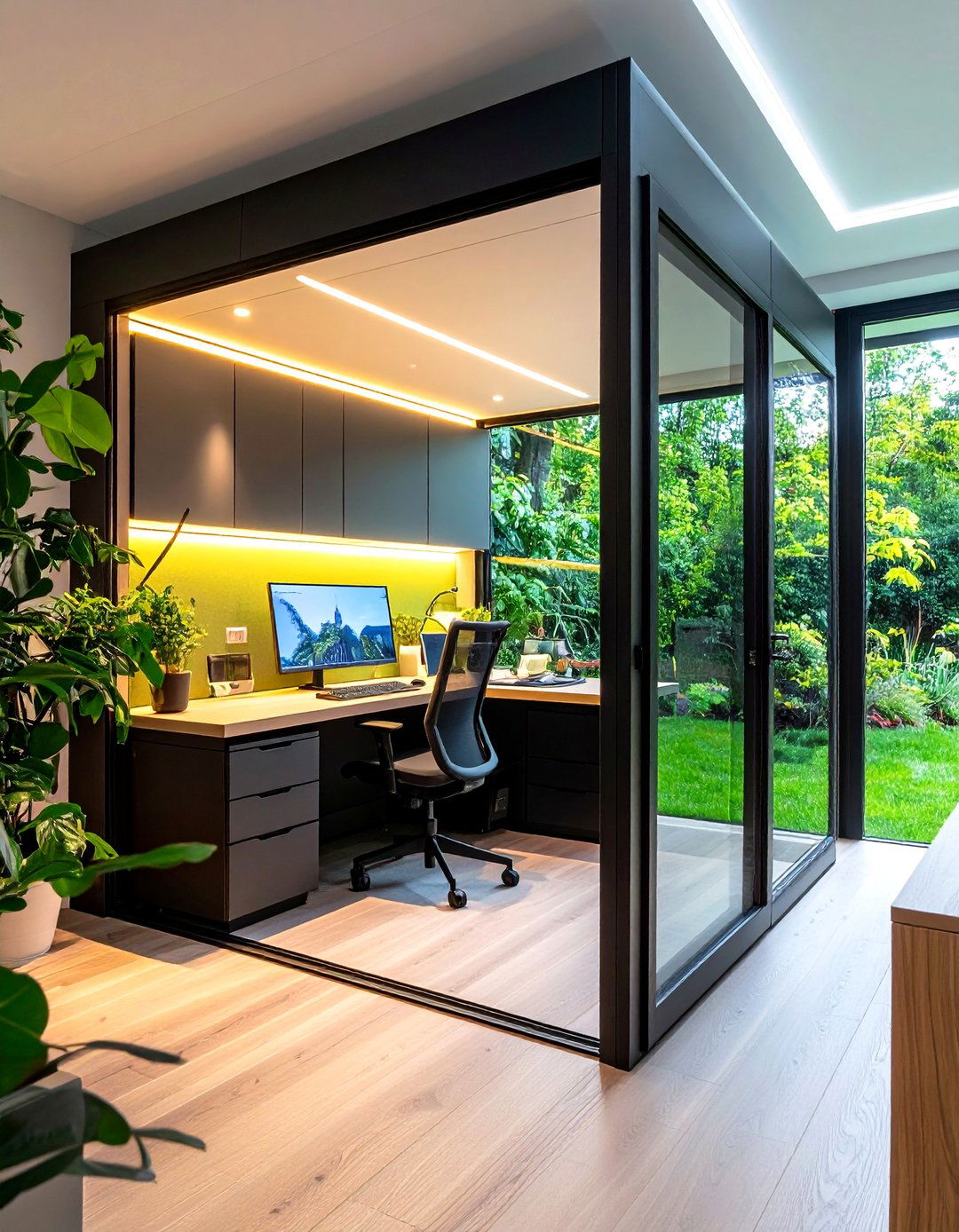
Remote work continues to surge, and the garage’s perimeter walls make superb anchors for built-in desks and acoustic panels. Start with a thick area rug and dual-pane window upgrade for noise dampening. Add a mini-split HVAC head above the monitor to maintain a steady 22 °C without tapping central air. LED task lamps boost focus, while a glass-panel door preserves privacy yet invites daylight. Because zoning treats the garage as non-habitable, check local codes—many permit detached “office” use so long as exits remain clear of vehicles.
12. Create a Mudroom Drop Zone at the Interior Threshold
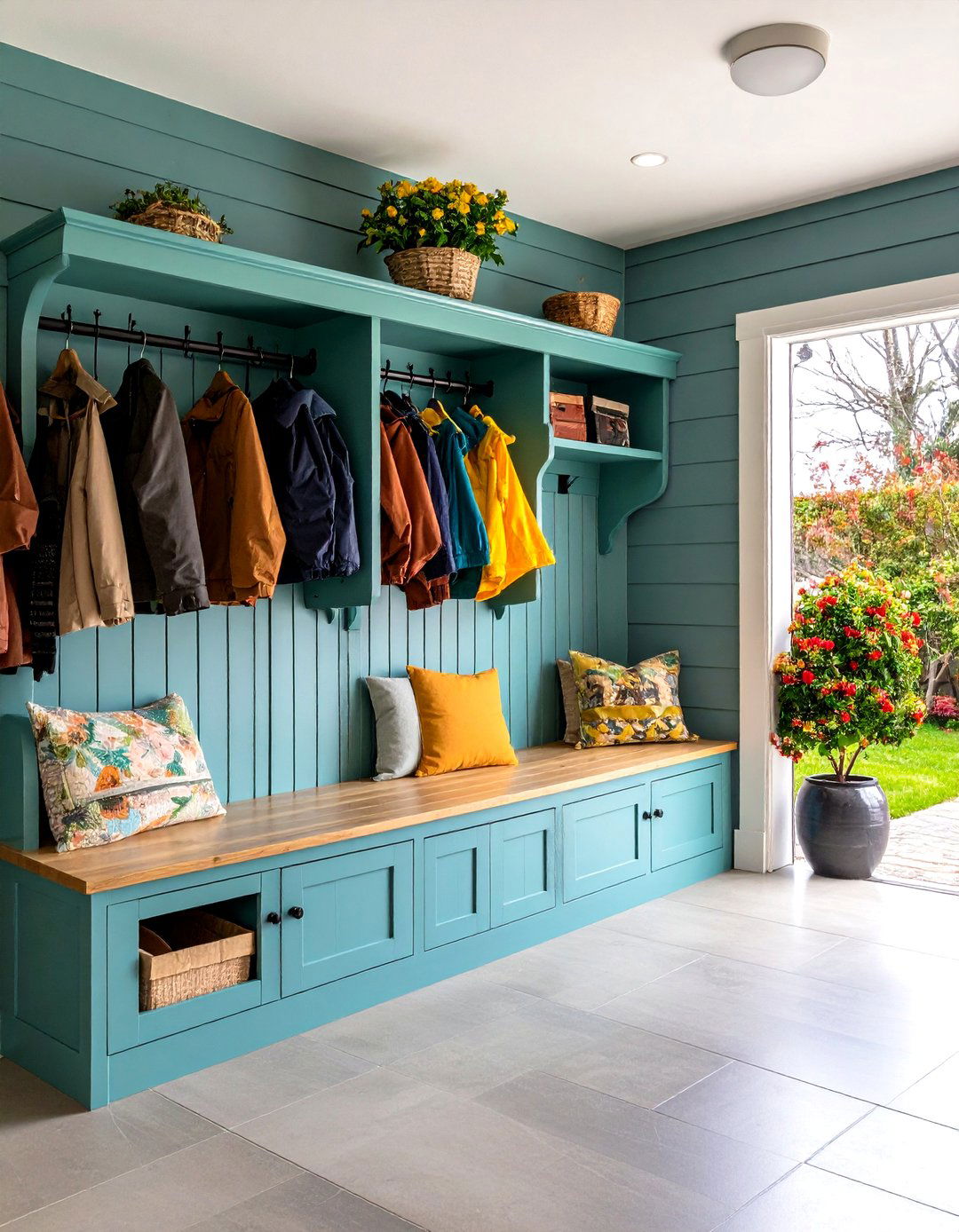
Shoes, backpacks, and umbrellas pile up fast, so convert the step into the house into a storage bench flanked by tall cubbies. Even narrow passages benefit when organisers exploit vertical height, an approach designers highlight in recent mudroom showcases. Moisture-proof beadboard, drip trays, and ventilated doors prevent odours; a locker for sports gear saves panic hunts before weekend games. Consider painting this niche a bright accent colour as a visual cue that says, “Pause here, de-clutter, then head inside.”
13. Install Modular Cabinets and a Rolling Workbench
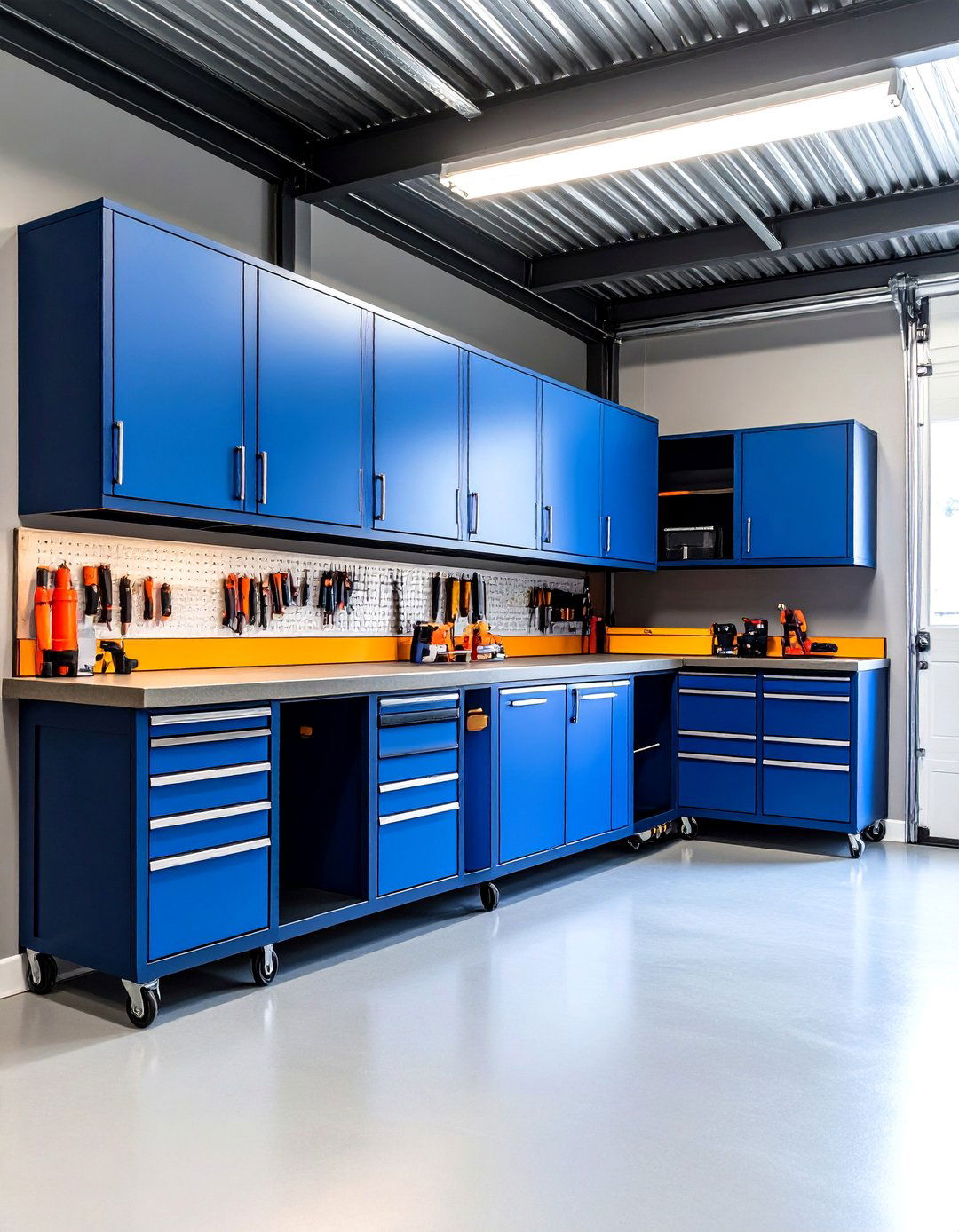
Powder-coated steel cabinets rated for 400+ kg per unit tame everything from paint cans to power-tool cases while giving the garage a crisp, unified aesthetic. Anchor uppers to studs, level base units, and finish with a maple or stainless work-surface that slides out on casters for big projects. Adjustable shelves adapt as tool collections evolve, and full-extension drawers keep small parts visible all the way to the back. Label fronts with vinyl decals so family members know exactly where items belong.
14. Add a Mobile Dust-Collection System for Woodworking
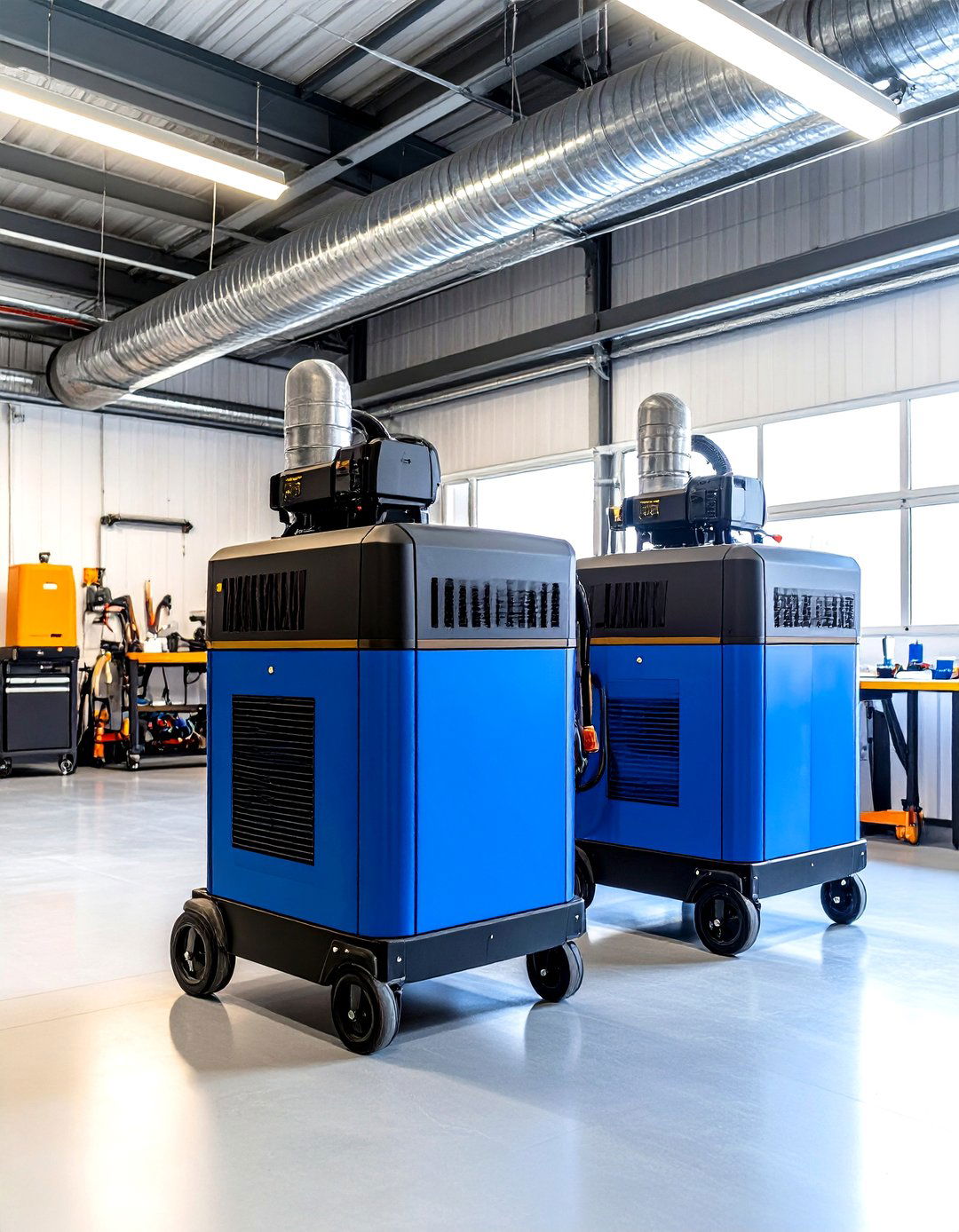
Fine sawdust coats cars and lungs alike, so even hobbyists should dedicate a 1 HP collector with a short 100 mm hose and high-micron pleated filter. Mount the unit on a dolly to roll between machines, then hang a secondary ceiling-mounted air scrubber that cycles the room’s volume through a HEPA filter in under ten minutes. Quick-release blast gates let you shut suction to idle tools, maximising airflow where needed and keeping storage spaces noticeably cleaner.
15. Improve Air Quality with an Exhaust Ventilation Fan
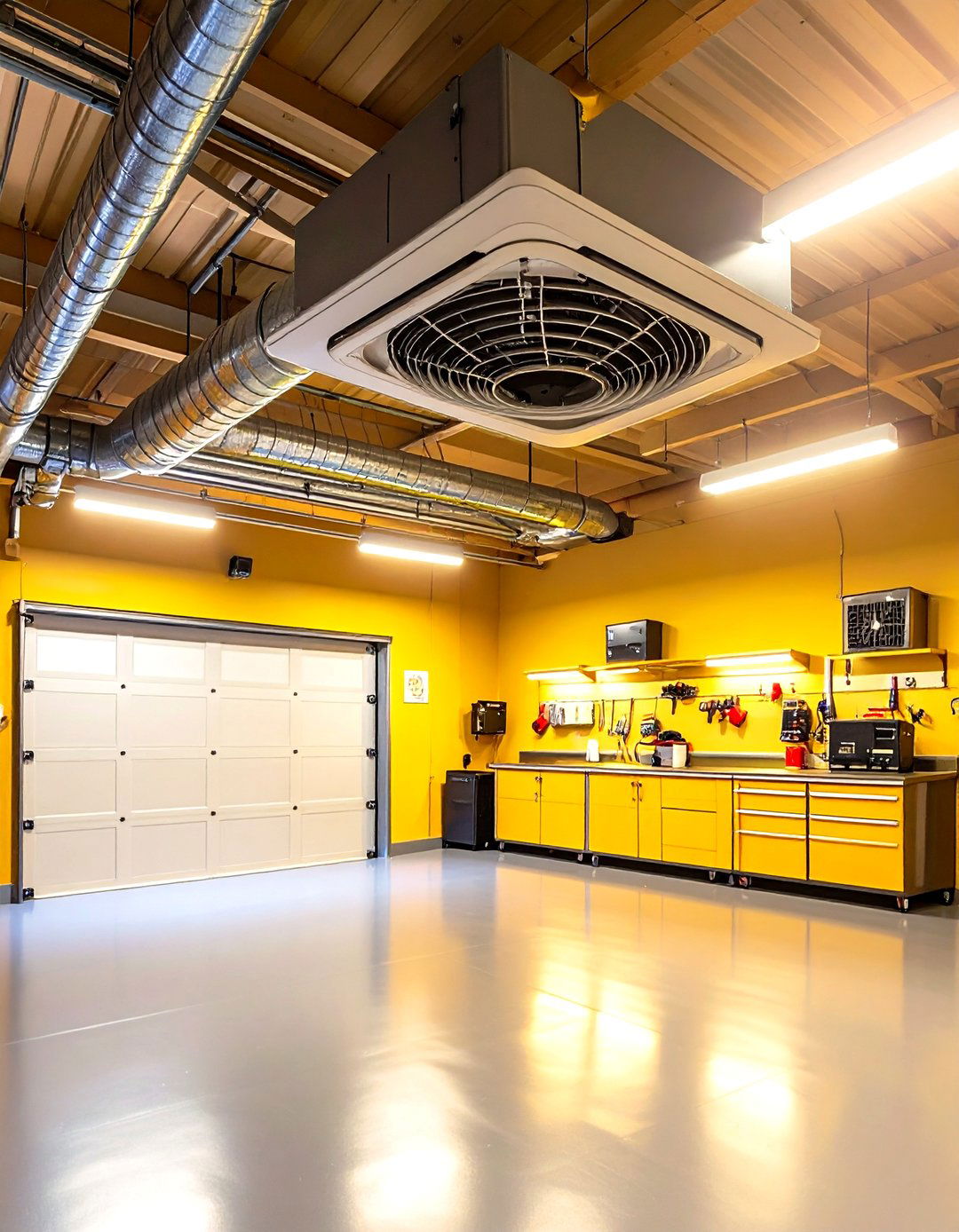
Combustion fumes and paint vapours linger unless actively expelled. A through-the-wall shutter fan wired to a humidity-temperature controller purges stale air on demand and helps dry wet floors after winter storms. Cut an opening between studs, frame it with treated timber, and caulk seams to block back-drafts. Pair with passive soffit vents or crack the roll-up door slightly so fresh air replaces what’s blown out, maintaining balanced pressure and protecting indoor-air quality for any adjoining living space.
16. Convert to a High-Lift Garage Door Track

If overhead storage or a car lift is on the wish list, reroute the door’s horizontal tracks closer to the ceiling. A high-lift kit re-positions the spring line and adds 30–40 cm of vertical clearance, instantly opening headroom for kayaks or rooftop tents. Because torsion springs store dangerous energy, many homeowners outsource this step, but advanced DIYers can follow manufacturer instructions with proper winding bars. Finish by extending safety cables and photo-eyes to their new heights.
17. Soundproof a Section for Music or Podcasting
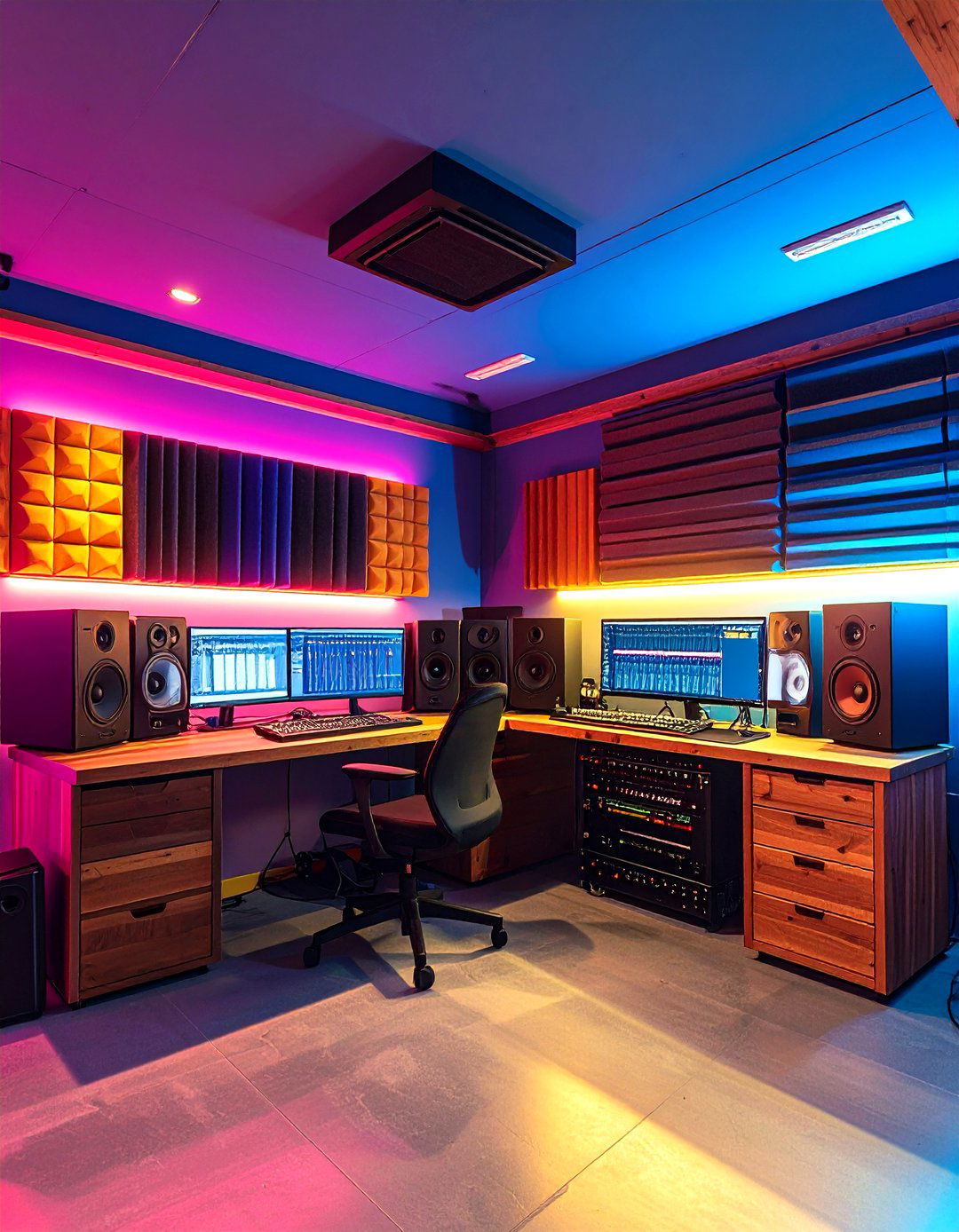
Pounding drums or late-night voiceovers need isolation. Build a room-within-a-room using staggered studs, mineral-wool insulation, and decoupled drywall channels; then add acoustic panels to tame echoes. Even partial treatments—like thick rugs and foam bass traps—ease neighbour complaints. Seal gaps around the service door with perimeter gaskets, and install a “quiet” ventilation baffle so fresh air enters without becoming a sound leak.
18. Mix Pegboard and Slatwall for Tool-Board Flexibility

Pegboard accessories remain cheaper and plentiful for lightweight hand tools, while slatwall excels at holding heavier gear. Combining both systems capitalises on each strength and future-proofs the garage. Mount pegboard above the bench for screwdrivers and wrenches you reach hourly; reserve slatwall strips beside the mower bay for hedge clippers and extension cords. Colour-code hooks—red for mechanical, blue for carpentry—so anyone can return tools to their rightful spot at a glance.
19. Introduce Natural Light with Frosted or Tinted Glass Panels
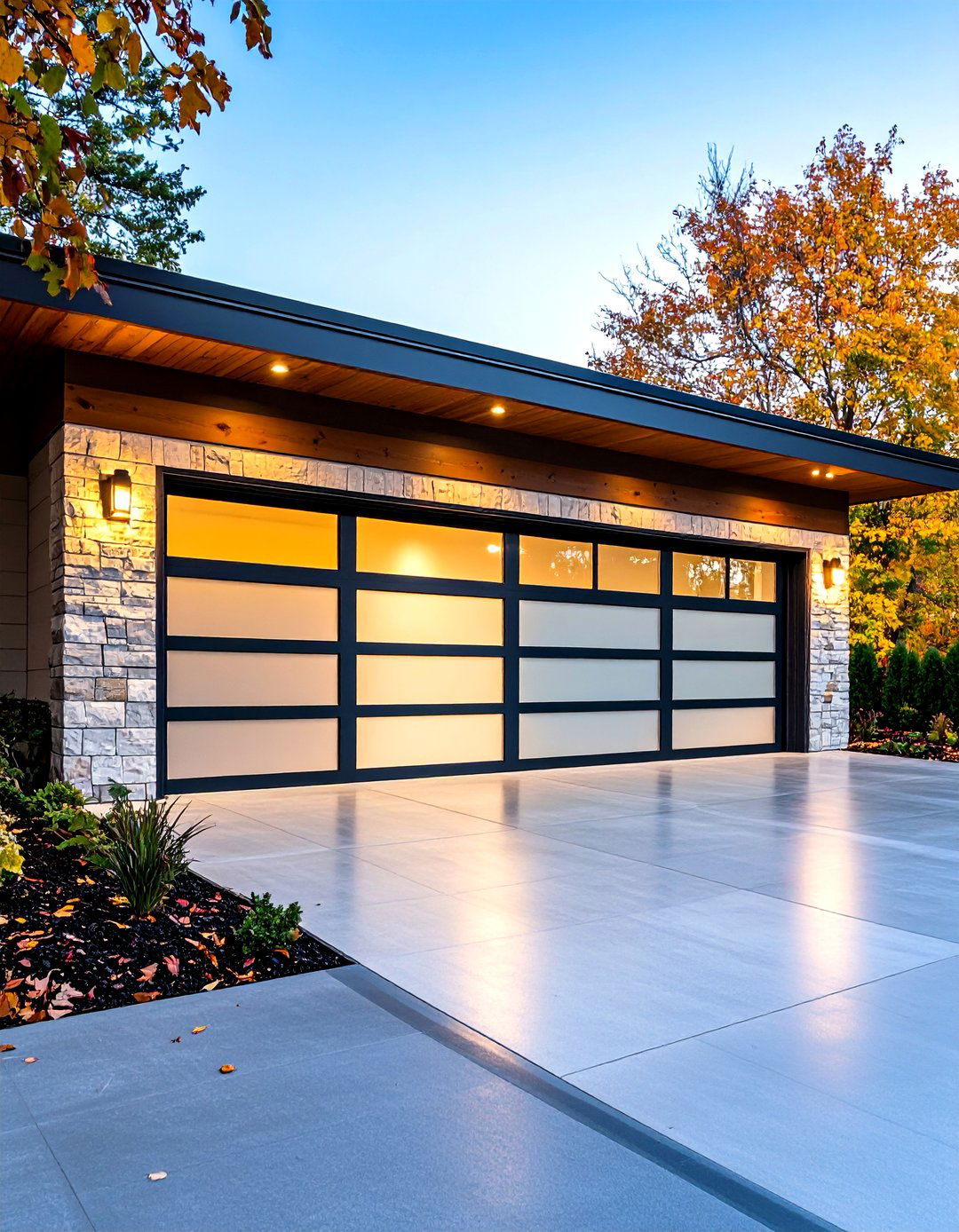
Swapping solid panels for frosted-glass inserts floods the garage with daylight while preserving privacy, a trend surging in 2025 multipurpose designs. Tempered panes diffuse glare yet still illuminate nooks, reducing daytime reliance on electric lights. If security is paramount, choose laminated glass with internal film and reinforce rails with locking struts. Coordinating the glass tint with front-door sidelights unifies exterior curb appeal and hints at the polished interior makeover within.
20. Finish with Colour, Graphics, and Comfortable Touches
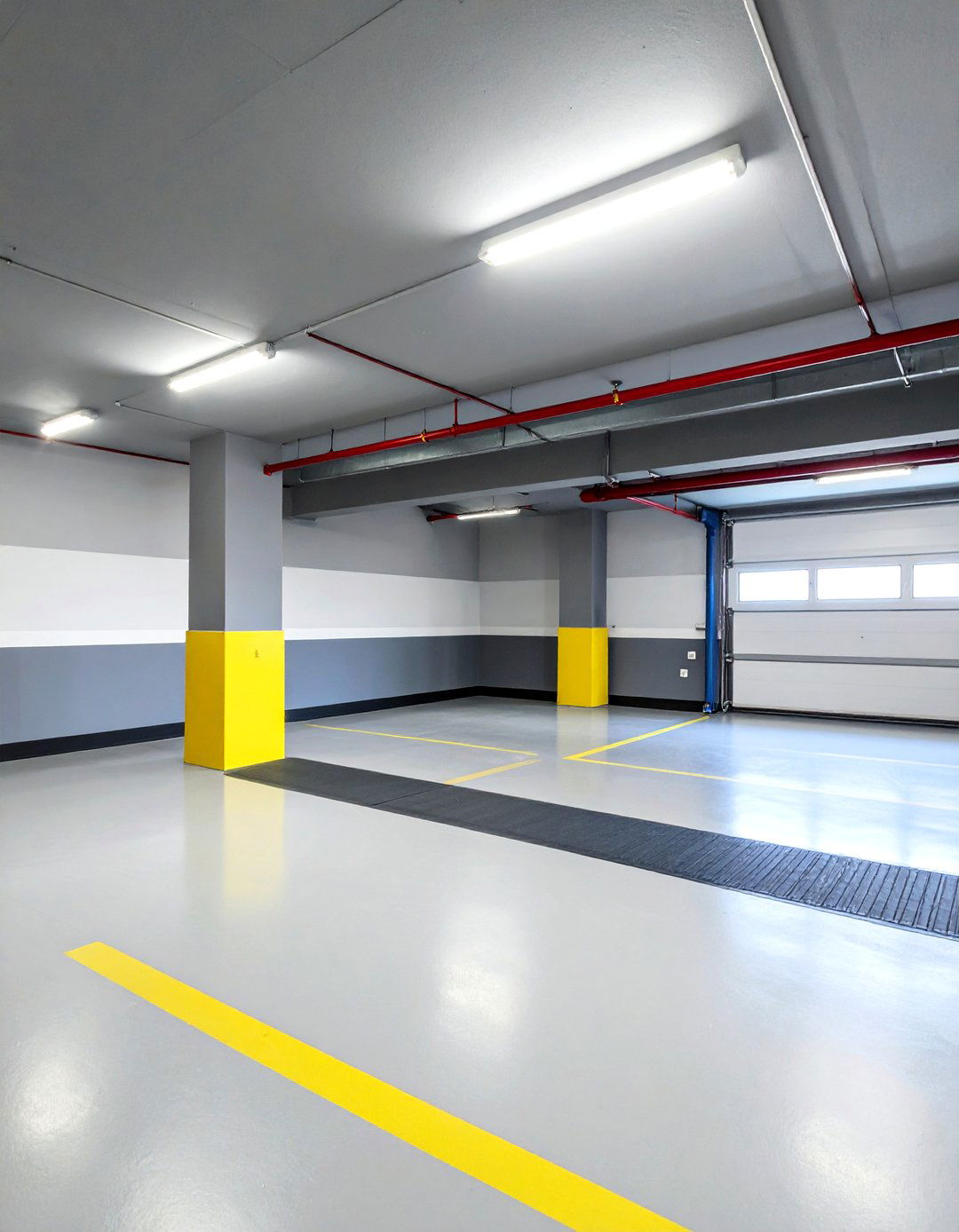
Finally, give the garage the same visual respect as any interior room. A light-reflective grey on walls, bold striping at dado height, and a clear polyurethane on exposed timbers pull the space together. Add a recycled-rubber runner along the main traffic lane, hang an oversized clock for workshop timing, and mount Bluetooth speakers out of splash range. These finishing layers turn functional upgrades into a space that feels intentional—a room you’ll actually show guests, not just hide behind a closing door.
Conclusion:
Elevating your garage is less about one grand renovation and more about stacking purposeful micro-improvements: smart storage to banish clutter, rugged floors and bright lights to boost usability, and climate-control tweaks that make the room comfortable year-round. Each idea above can stand alone, yet when combined they create a harmonious, high-performance extension of your home—proof that the garage is no longer a dusty afterthought but a flexible, value-adding hub ready to evolve with every new project.




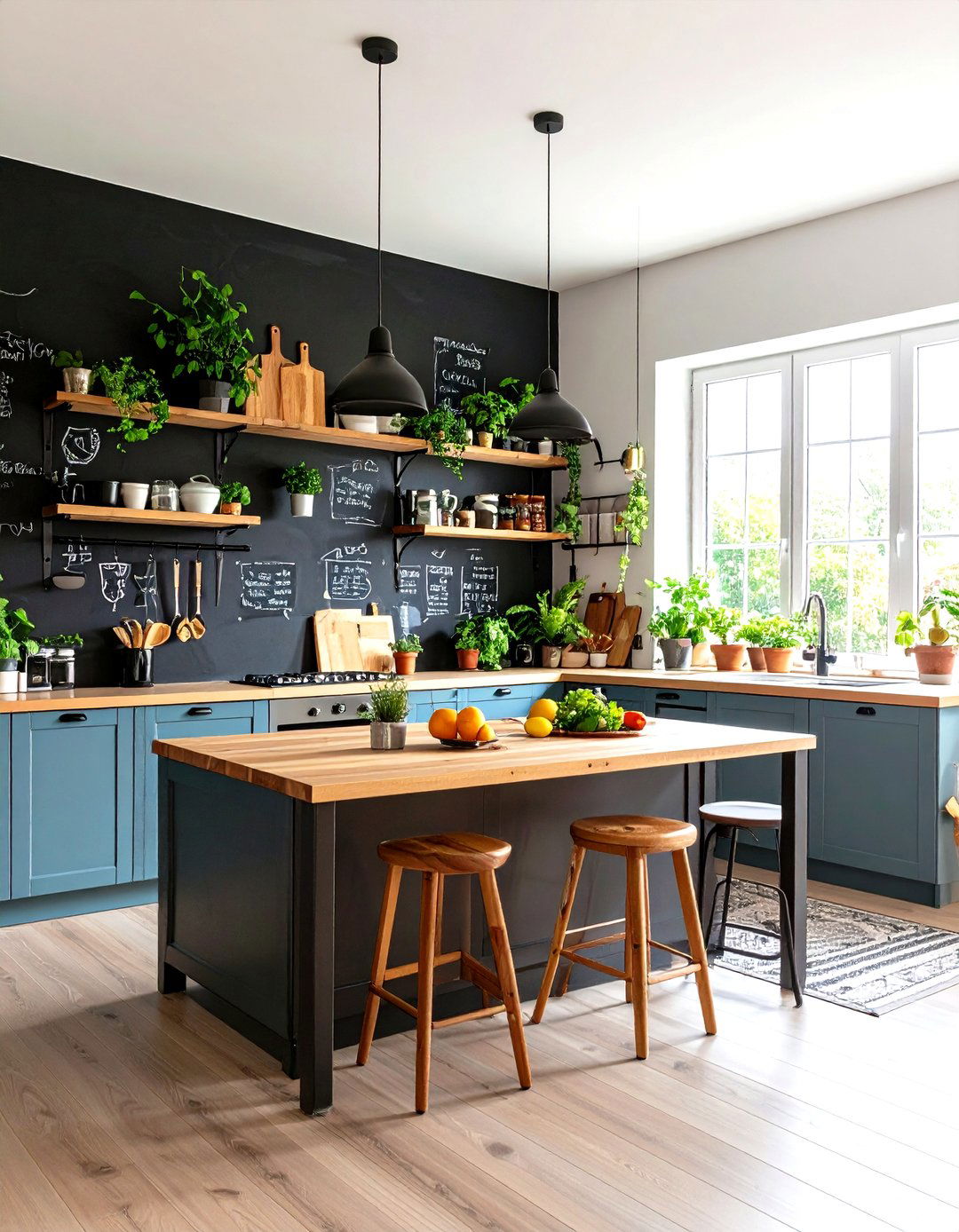





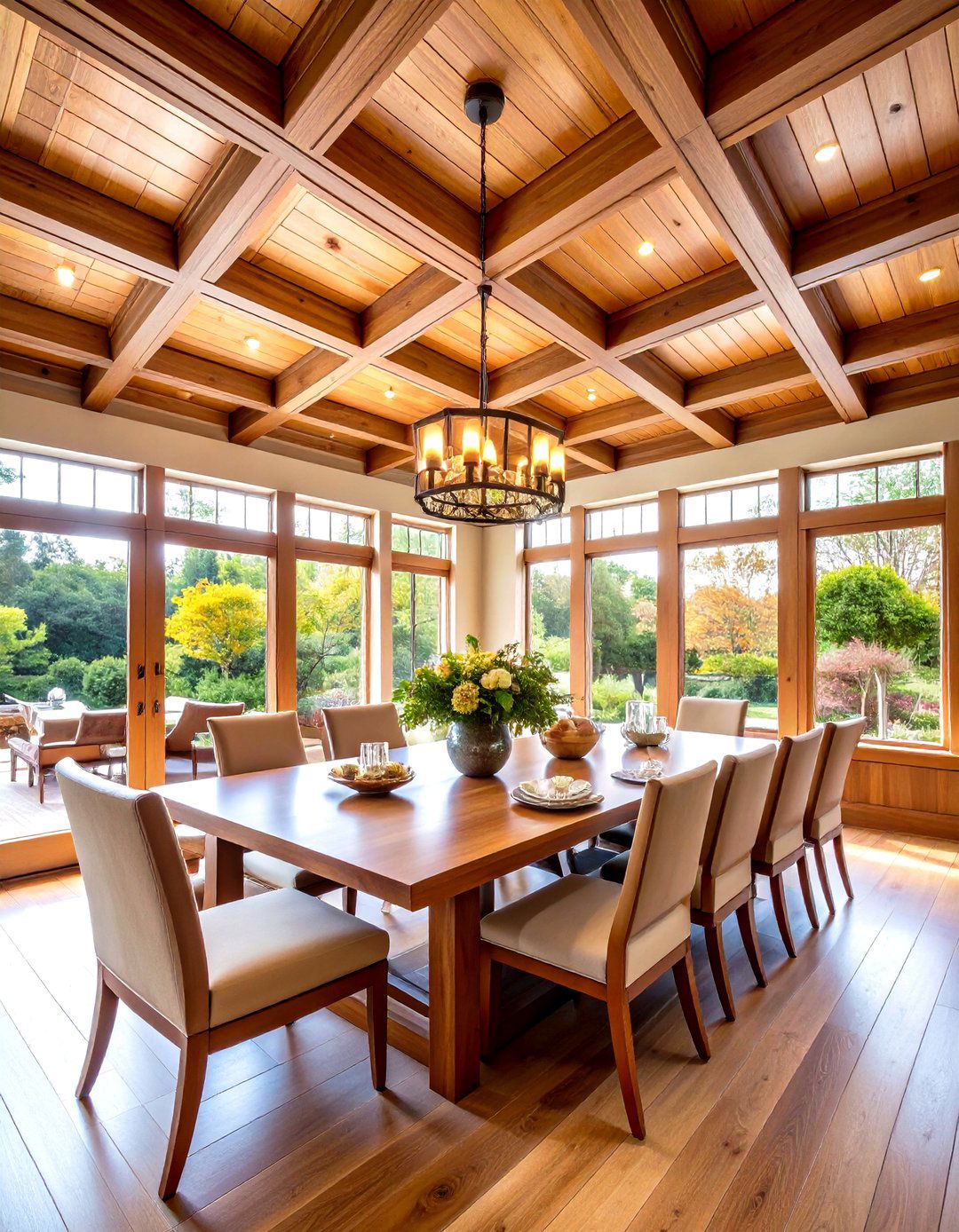
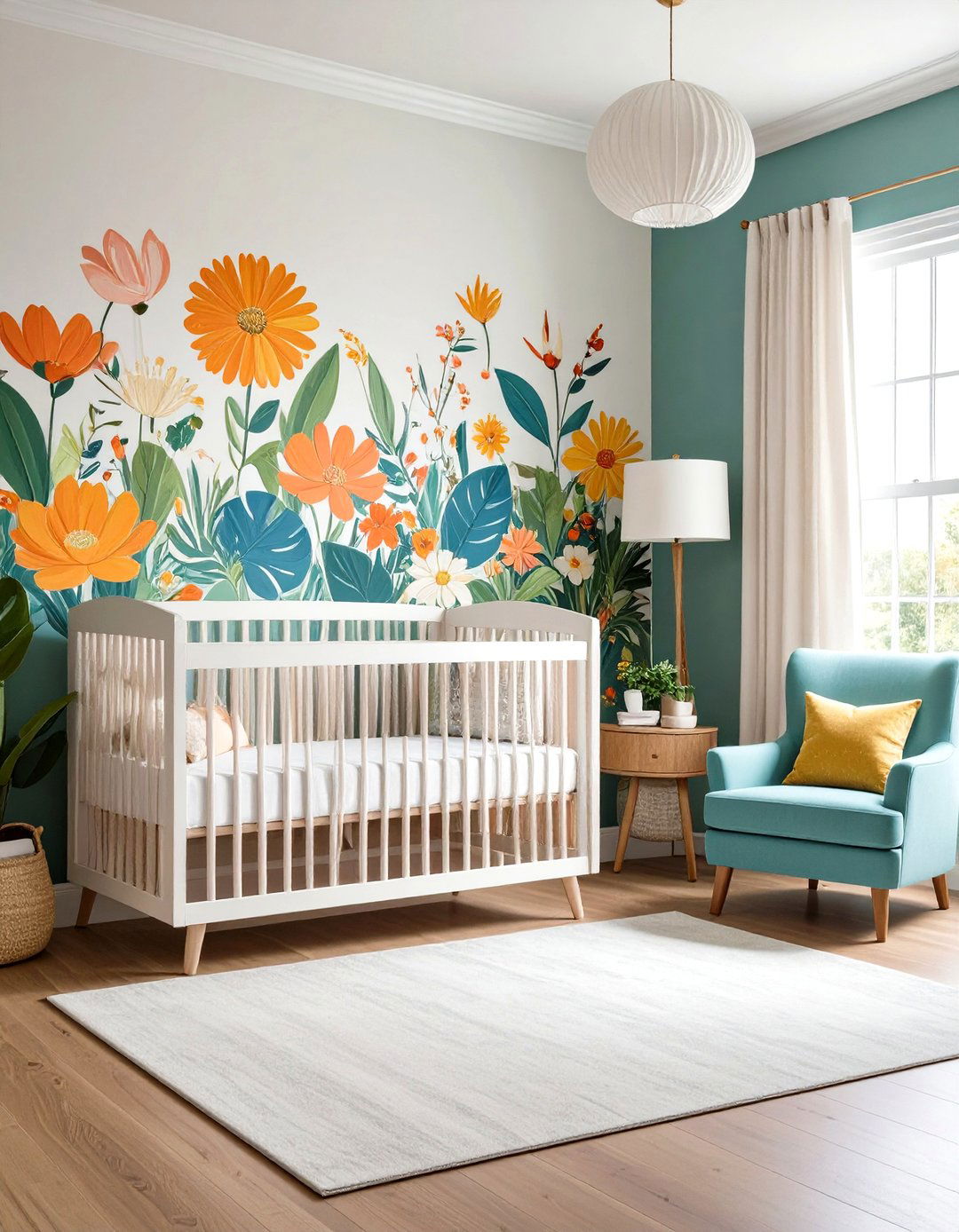



Leave a Reply